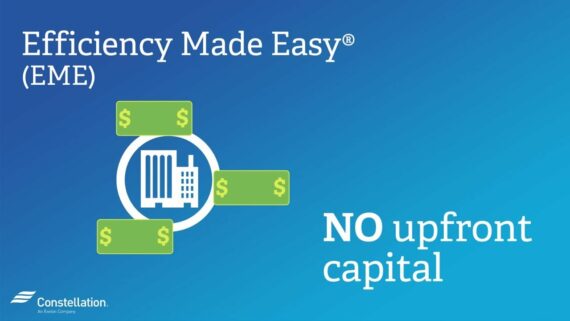Commercial Energy Audits: Do Virtual Energy Audits Stack up to Traditional Onsite Audits?
New Technology Collects Energy Data Remotely
Commercial buildings in the U.S. spend more than $100 billion on utility bills annually and are responsible for approximately 20 percent of the nation’s energy use. Considering that 30-50 percent of energy use is routinely wasted, and it’s easy to see why building owners are becoming more serious about making energy-efficiency improvements within their facilities. To figure out which improvements make the most sense, owners usually turn to HVAC professionals to conduct comprehensive energy audits, which are used to thoroughly evaluate existing mechanical systems.
While energy audits have traditionally occurred on-site, some firms are offering virtual energy audits, which they say are faster and more cost-effective than on-site audits. Some say there is no substitute for being on-site and verifying the actual operating conditions of a building. Others note virtual and on-site energy audits may complement one another, resulting in a broader collection of data that can ultimately be used to justify improvements designed to lower a building’s energy costs as well as benefit the indoor environment.
How it Works
A virtual energy audit remotely analyzes meter data to determine how a building is consuming energy and recommends efficiency improvements. Solution providers use a variety of analytical approaches to compute the data and recommend improvements.
Retroficiency’s Virtual Energy Assessment (VEA), for example, uses rapid energy modeling techniques in order to detect key building attributes, including type, end-use consumption, operational characteristics, etc. These factors identify how the structure is performing, how that performance could shift with more energy-efficient operations and systems, and suggests specific changes that could help to achieve those performance improvements, said Mike Kaplan, vice president of marketing, Retroficiency. “Each building-level report is based on an assessment of performance from a number of distinct angles, including time of day and season,” said Kaplan. “By pairing meter data with external data, such as weather, VEA’s algorithms gain insights to determine how much energy is consumed by each end-use system (heating, cooling, lighting, etc.). VEA then helps to hone in on the greatest savings potential and the operational and retrofit opportunities that exist within each individual building.”
Retroficiency works directly with power utilities and energy service providers (ESPs) to conduct assessments of large portfolios of buildings as well as individual locations. In most scenarios, Retroficiency receives 15-minute-interval consumption data from the utility or ESP customer, and, once the data is uploaded, performs the assessment in minutes per building. If this information is not available, customers can provide monthly building meter (energy consumption) data, which can be used to prioritize buildings and engage customers.
“Although monthly data provides less insight into the building, it still directs the utilities/ESPs to which areas have the greatest savings potential to begin a conversation with building owners and managers,” said Kaplan.
With Gridium’s RCx software, local energy auditors can purchase per-building subscriptions, which allow access to a set of advanced analytics to model interval data, enable fault detection, and perform statistical diagnostics to identify temperature response and building schedules, said Tom Arnold, CEO, Gridium. “With the building’s zip code, RCx can pair the building’s interval data with local weather station data, enabling fast identification of the most valuable energy-efficiency measures found in a retro-commissioning study including run time and other controls-related opportunities.”
Arnold notes that while virtual audits can’t replace the measurement and verification (M&V) that occurs by walking into a facility and investigating the sub-systems, RCx does enable the user to track weather-adjusted building drift driven by operational changes (including precise visual representations). “Additionally, our product, Billcast, provides a high-level M&V analysis by disaggregating monthly utility bill variance [from one year to the next] into weather, rate, calendar, and operational effects.”
Virtual energy audits also cost less and significantly reduce the time spent on-site through prioritization and preparation, said Arnold. “RCx is priced at a rate that tends to obviate the payback discussion. In addition, engineering firms save a tremendous amount of time by being able to quickly analyze a building’s interval and weather data, while building owners and operators are able to turn their smart meter data into actionable insights.”
There is no question that virtual energy audits are revolutionizing the way the industry targets building energy waste, said Kaplan. “Leveraging the growing availability of building data, the proliferation of cloud computing, and new advancements in analytics to facilitate rapid, mass-scale generation of data-driven insights and models provides a sophisticated understanding of how a building uses and loses energy and how it can improve, all without ever setting foot on-site.”
On-site Benefits
The problem with virtual audits is that they often rely too much on unverified information, said Robert Vessie, director of business development, Sander Mechanical Service, Branchburg, New Jersey. “In our experience, there is no substitute to being on-site and collecting/verifying the actual as-built and operating conditions of the various building systems. Often times, what building owners and operators may believe to be the case is not always accurate, and the lack of correct and complete information can lead the audit down the wrong path.
“We feel virtual energy audits may have some limited market penetration for certain budget-conscious or niche customers where complete information is readily available and easily transmittable; but, we feel their usefulness and applicability will remain limited,” said Vessie. “For more complex facilities, and in those where gaps in information and reliability of information are factors, there really is no substitute for a traditional on-site energy audit with field verification of all building systems. The on-site auditing process also provides the opportunity to build rapport and trust through in-person customer interaction, which always yields better outcomes.”
While Lantern Energy LLC, Norwich, Connecticut, does not offer virtual energy audits, energy manager, Morgan Kennedy, appreciates the benefits they offer. “They might help with simpler, more easily quantified items like lighting, as they can be done quickly and require minimal experience with the materials involved. But, the limitation is the accuracy of the information, both on a materials front and a familiarity with building performance.”
Lantern Energy started offering commercial energy audits in 2009 in order to help customers maximize efficiencies, reduce their environmental impact, and improve their bottom lines. Their commercial energy audits include a look at a building’s present energy usage as it compares to similar buildings serving comparable functions. The on-site audit includes a walkthrough of the facility in which they examine the building’s envelope, HVAC system, refrigeration systems, motors and compressor systems, lighting, and existing automation systems.
Kennedy thinks virtual energy audits will become true competition to on-site audits as more information on building performance is quantified. “I would not be surprised if energy audits become more of a system diagnostic in the years to come. There will still be a role for on-site auditing, as special circumstances will always present themselves, but the more accurate benchmarking tools and metrics become, the more likely the savings from an energy audit will be quantified up front with the site visit used to determine where deviance in usage comes from.”
Kaplan believes virtual audits complement — not replace — traditional on-site energy audits. “Virtual audits focus resources on buildings that have the greatest savings potential. They also help on-site auditors during their analyses, because they can identify operational issues in a building that may be missed during a standard walkthrough. Likewise, a trained, on-site energy engineer may be able to identify specific, granular equipment upgrades or efficiency opportunities that provide further detail to issues identified by a virtual assessment. This additional analysis is very often required before a building owner or manager can make an informed decision about whether to do a retrofit project.”
Given the vast number of commercial buildings that could benefit from energy auditing, it seems there may be room for both virtual and traditional on-site audits. “To put it in perspective, using only traditional on-site methods, it would cost up to $50 billion and take up to 22 years to audit every building in the U.S. alone,” said Kaplan. “The increasing adoption of virtual assessments is both environmental and economic in nature, driven by the need to wring every savings opportunity out of every building at a greater speed and scale and at a lower cost than traditional approaches alone.”
SIDEBAR: 17 Steps to an Effective Energy Audit
For more than five years, Sander Mechanical Service, Branchburg, New Jersey, has been offering solutions such as automated demand response, Energy Star performance benchmarking, energy auditing, and identification of energy conservation measures. While energy audits may vary from one customer to the next, a typical audit for Robert Vessie, director of business development, Sander Mechanical, includes the following:
• Evaluate utility bills;
• Establish/compare baseline energy use;
• Assess commodity acquisition practices;
• Provide a short- and long-term commodity acquisition plan;
• Interview facilities personnel to understand building operations, occupied hours, usage parameters, planned or recent renovations, etc.;
• Generate an Energy Star benchmark score;
• Compare the Energy Utilization Index (EUI) and cost index with facilities having similar characteristics;
• Derive target energy, demand, and cost indices for a facility with the same characteristics as an audited facility;
• Review available mechanical/electrical/plumbing plans;
• Conduct a thorough building survey;
• Compile/generate inventory of energy systems (e.g. lighting, HVAC, refrigeration, water heating, motors, pumps, process equipment, controls, building envelope, etc.);
• Evaluate/assess age, condition, operating hours, and set points of equipment;
• Complete an energy conservation measures study;
• Identify low-cost/no-cost changes to the facility or to operating and maintenance procedures;
• Identify recommended capital improvements/energy conservation (and renewable energy) measures that are cost-effective for the structure’s life cycle;
• Identify applicable federal, state, and utility incentives that energy conservation measures qualify for; and
• Generate savings and a return on investment (ROI) analysis, including a prioritized list of investments using a decision matrix that addresses both short- and long-term investment opportunities.








This is a nice post. thank you for sharing this. one major advantage of virtual audits is their ability to rapidly assess a buildings energy profile. according also to retroficiency, once data is received, analysis time takes only minutes per building and thousands of buildings can be processed simultaneously.